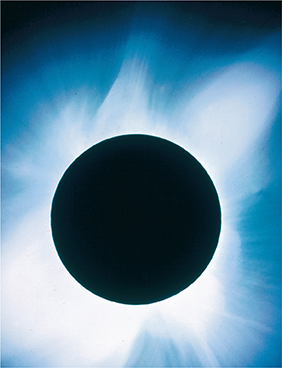Convection zone
Energy from the radiation zone passes into the convection zone, the outer layer of the sun's interior. In the convection zone, energy is transferred outward mainly by convection currents. Hot gases in the convection zone rise toward the sun's atmosphere while cooler gases sink downward.
The Sun's Atmosphere
Outside the convection zone is the sun's atmosphere.  The sun's atmosphere consists of three layers: the photosphere, the chromosphere, and the corona.
The sun's atmosphere consists of three layers: the photosphere, the chromosphere, and the corona.
Photosphere
The innermost layer of the sun's atmosphere, which is the visible surface of the sun, is the photosphere (FOH tuh sfeer). It is about 500 kilometers thick and has an average temperature of about 5800 K. Although the photosphere is not solid, it is called the sun's surface. Astronomers can't see through it to the sun's interior. The photosphere's surface has a bubbly appearance. The bubbles, called granules, are the tops of convection currents that carry energy from the sun's interior.
Figure 5 The corona can only be seen from Earth during a total solar eclipse or when viewed with a special telescope.

Chromosphere
Just outside the photosphere is the chromosphere (KROH muh sfeer), the middle layer of the sun's atmosphere. Temperature increases to nearly 10,000 K as you move upward through the chromosphere. At such high temperatures, hydrogen gas emits a reddish light. This light gives the chromosphere its name, which means “sphere of color.” The faint chromosphere is normally visible only when the brighter photosphere is blocked, such as during a total solar eclipse.
Corona
The chromosphere merges with the corona, the outermost layer of the sun's atmosphere. The gases in the corona are so thin that the corona, like the chromosphere, is usually seen only during solar eclipses. Gases in the corona are very hot, about 1 million kelvins. But the corona has such a low density that the total amount of thermal energy in it is relatively small.
The corona, shown in Figure 5, extends millions of kilometers above the chromosphere. It gradually thins into the solar wind, a stream of electrically charged particles that flows outward from the sun through the solar system. As the solar wind approaches Earth, Earth's magnetic field deflects the charged particles. These particles enter the atmosphere only near Earth's magnetic poles. There they can interact with molecules in the atmosphere, producing auroras.






